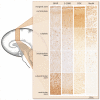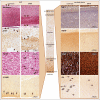Vulnerability of the fetal primate brain to moderate reduction in maternal global nutrient availability
- PMID: 21252306
- PMCID: PMC3041099
- DOI: 10.1073/pnas.1009838108
Vulnerability of the fetal primate brain to moderate reduction in maternal global nutrient availability
Abstract
Moderate maternal nutrient restriction during pregnancy occurs in both developing and developed countries. In addition to poverty, maternal dieting, teenage pregnancy, and uterine vascular problems in older mothers are causes of decreased fetal nutrition. We evaluated the impact of global 30% maternal nutrient reduction (MNR) on early fetal baboon brain maturation. MNR induced major cerebral developmental disturbances without fetal growth restriction or marked maternal weight reduction. Mechanisms evaluated included neurotrophic factor suppression, cell proliferation and cell death imbalance, impaired glial maturation and neuronal process formation, down-regulation of gene ontological pathways and related gene products, and up-regulated transcription of cerebral catabolism. Contrary to the known benefits from this degree of dietary reduction on life span, MNR in pregnancy compromises structural fetal cerebral development, potentially having an impact on brain function throughout life.
Conflict of interest statement
The authors declare no conflict of interest.
Figures



Comment in
-
The vulnerable developing brain.Proc Natl Acad Sci U S A. 2011 Feb 15;108(7):2641-2. doi: 10.1073/pnas.1019726108. Epub 2011 Feb 4. Proc Natl Acad Sci U S A. 2011. PMID: 21297035 Free PMC article. No abstract available.
Similar articles
-
Effect of 30 per cent maternal nutrient restriction from 0.16 to 0.5 gestation on fetal baboon kidney gene expression.J Physiol. 2006 Apr 1;572(Pt 1):67-85. doi: 10.1113/jphysiol.2006.106872. Epub 2006 Mar 2. J Physiol. 2006. PMID: 16513668 Free PMC article.
-
Effects of maternal global nutrient restriction on fetal baboon hepatic insulin-like growth factor system genes and gene products.Endocrinology. 2009 Oct;150(10):4634-42. doi: 10.1210/en.2008-1648. Epub 2009 Jul 2. Endocrinology. 2009. PMID: 19574404 Free PMC article.
-
Effect of 30% nutrient restriction in the first half of gestation on maternal and fetal baboon serum amino acid concentrations.Br J Nutr. 2013 Apr 28;109(8):1382-8. doi: 10.1017/S0007114512003261. Epub 2012 Oct 9. Br J Nutr. 2013. PMID: 23046718 Free PMC article.
-
The insulin-like growth factor system and the fetal brain: effects of poor maternal nutrition.Rev Endocr Metab Disord. 2007 Jun;8(2):71-84. doi: 10.1007/s11154-007-9044-2. Rev Endocr Metab Disord. 2007. PMID: 17653868 Review.
-
Biological mechanisms for nutritional regulation of maternal health and fetal development.Paediatr Perinat Epidemiol. 2012 Jul;26 Suppl 1:4-26. doi: 10.1111/j.1365-3016.2012.01291.x. Paediatr Perinat Epidemiol. 2012. PMID: 22742599 Review.
Cited by
-
Multigenerational effects of parental prenatal exposure to famine on adult offspring cognitive function.Sci Rep. 2015 Sep 3;5:13792. doi: 10.1038/srep13792. Sci Rep. 2015. PMID: 26333696 Free PMC article.
-
IGFBP-1 hyperphosphorylation in response to nutrient deprivation is mediated by activation of protein kinase Cα (PKCα).Mol Cell Endocrinol. 2021 Oct 1;536:111400. doi: 10.1016/j.mce.2021.111400. Epub 2021 Jul 24. Mol Cell Endocrinol. 2021. PMID: 34314739 Free PMC article.
-
The nonhuman primate hypothalamo-pituitary-adrenal axis is an orchestrator of programming-aging interactions: role of nutrition.Nutr Rev. 2020 Dec 1;78(Suppl 2):48-61. doi: 10.1093/nutrit/nuaa018. Nutr Rev. 2020. PMID: 33196092 Free PMC article. Review.
-
Strength of nonhuman primate studies of developmental programming: review of sample sizes, challenges, and steps for future work.J Dev Orig Health Dis. 2020 Jun;11(3):297-306. doi: 10.1017/S2040174419000539. Epub 2019 Sep 30. J Dev Orig Health Dis. 2020. PMID: 31566171 Free PMC article. Review.
-
Baboons as a model to study genetics and epigenetics of human disease.ILAR J. 2013;54(2):106-21. doi: 10.1093/ilar/ilt038. ILAR J. 2013. PMID: 24174436 Free PMC article. Review.
References
-
- The State of Food Insecurity in the World. Rome: Food and Agriculture Organization of the United Nations; Food and Agriculture Organization of the United Nations (2004)
-
- United Nations International Children's Emergency Fund. State of the World's Children. New York: Oxford Univ Press; 2001.
-
- Baker PN, et al. A prospective study of micronutrient status in adolescent pregnancy. Am J Clin Nutr. 2009;89:1114–1124. - PubMed
-
- Beard JR, et al. Socioeconomic and maternal determinants of small-for-gestational age births: Patterns of increasing disparity. Acta Obstet Gynecol Scand. 2009;88:575–583. - PubMed
Publication types
MeSH terms
Substances
Grants and funding
LinkOut - more resources
Full Text Sources
Other Literature Sources
Medical

